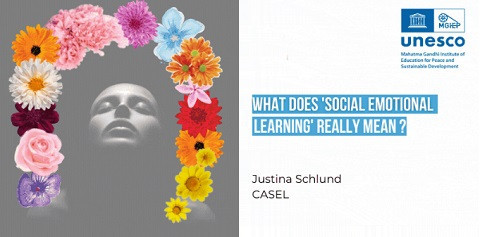
GCED Basic Search Form
Quick Search
You are here
News

22 July 2021, Justina Schlund (CASEL)
In school systems around the world, there’s growing appreciation of the importance of social and emotional learning (SEL). But ask a few people to define SEL, and you’re likely to hear a few different responses.
One of the most widely cited definitions is that of our nonprofit, the Collaborative for Academic, Social, and Emotional Learning (CASEL). At its core, SEL is the process through which all young people and adults acquire and apply the knowledge, skills, and attitudes to develop healthy identities, manage emotions and achieve personal and collective goals, feel and show empathy for others, establish and maintain supportive relationships, and make responsible and caring decisions.
In schools, SEL can take many different forms, but often involves a focus on building positive relationships among students and adults, dedicated time to learn social and emotional skills, and weaving in opportunities for students to practice reflection and collaboration during academic subjects. SEL also provides schools with ways to work more closely with families and community partners to develop shared priorities and coordinate practices across different places where students live and learn.
Here are five facts to help your community align around a clear understanding of SEL:
1. SEL is for everyone.
Learning and practicing self-awareness, self-management, social awareness, relationship skills, and responsible decision-making creates a foundation for any goal you hope to achieve — whether it relates to school, career, family, or civic life. That’s why SEL is important for all students no matter their academic levels, ability types, behavior records, or home lives. In fact, SEL isn’t limited to students. It also helps adults examine their own feelings and thoughts, manage stress, collaborate with colleagues, navigate different perspectives, and make caring choices.
Key takeaway: Take a systemic approach to SEL that actively involves all students and adults in learning and practicing social and emotional competencies.
2. SEL is grounded in science.
A large body of research across multiple countries shows the impact of SEL on a wide range of outcomes that support students’ success and well-being. Focused on what we learn and how we learn, SEL draws from brain science and practical implementation to highlight how best to promote healthy development. Research has shown that we think and learn best when we have supportive relationships, feel a sense of security and belonging, and have opportunities to develop and practice our social, emotional, and cognitive skills across many different contexts.
Key takeaway: Ensure SEL implementation stays true to the science by using evidence-based programs and continuous improvement processes.
3. SEL bolsters academic learning.
One important outcome of SEL is that it increases students’ academic performance. SEL builds skills that boost academic achievement in core subject areas while creating the relationships and environments that are most conducive to learning. In fact, 93% of teachers want a greater focus on SEL in schools because they know that it improves students’ academic performance, classroom behaviors, and attitudes about school.
Key takeaway: Look for indicators of SEL in classrooms and schools, including supportive classroom environments, SEL integrated into academic instruction, and explicit teaching of SEL.
4. SEL builds on strengths.
SEL gives students opportunities to learn about, appreciate, and build on their unique talents, interests, perspectives, and experiences. While SEL helps reduce risky behaviors and improve mental health, it’s not intended to “control” children’s behaviors or diagnose problems. Instead, it’s meant to enhance the many social and emotional strengths that all students already possess.
Key takeaway: Adopt strengths-based SEL practices and assessments, ensure discipline policies promote SEL, and use SEL to elevate student voice.
5. SEL extends across schools, homes, and communities.
SEL is about students, educators, families, and communities working together to create learning experiences and environments that best promote social, emotional, and academic growth. Rather than the work solely of teachers or parents, this coordination ensures students have consistent opportunities to learn and practice SEL across all the places where they live and learn. This also means that SEL isn’t one-size-fits-all, but that school-family-community partnerships determine the shared vision, goals, and plans for SEL in their communities.
Key takeaway: Partner with students, families, and community partners to develop SEL plans and continuously improve implementation.
By aligning around a clear and consistent definition of SEL, we can bring together coalitions of students, schools, families, and communities to underscore why this work is so important. Together, we can create the learning opportunities and environments that all students deserve.
